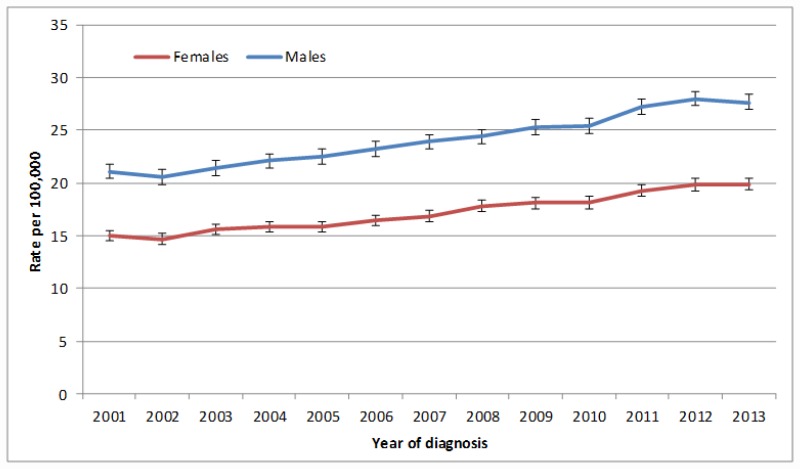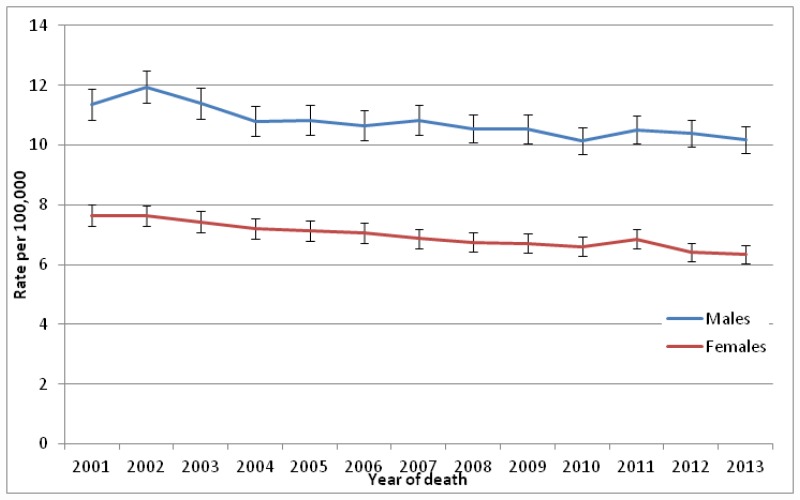Non-Hodgkin's lymphoma (NHL) is the 6th most common type of cancer in the UK (CRUK, 2012). It is more common in people aged over 65 years (Figure 1) and the increasing age of the population therefore impacts markedly on the total number of patients with NHL. NHL is more frequent in men than in women (Figure 2), and in 2013 the age standardised rate of NHL in England per 100,000 of the population was 27.6 for men and 19.9 for women. This equated to 6,195 newly diagnosed men and 5,218 newly diagnosed women in that year. There has been a moderate increase in the reported age standardised incidence of NHL in England since 2001 but it is not clear whether this is a true increase in the incidence of the disease or is a reflection of improved diagnostic testing. It is noteworthy that the major part of the apparent increase has been in people aged 70 years which may be a result of more rigorous investigation of elderly patients. There has been no reported increase in the incidence of NHL in Wales over the same time-period. There is no evidence from the English data that the incidence of NHL is influenced by socio-economic deprivation.

Figure 1
Incidence of non-Hodgkin lymphoma (ICD-10 code C82-C85), distribution of age at diagnosis, Persons, England 2013.

Figure 2
Incidence of non-Hodgkin lymphoma (ICD-10 code C82-C85), age-standardised rate per 100,000 by sex, England 2001-2013.
NHL is a heterogeneous group of malignancies with over 60 subtypes and 9 provisional sub-types. Two of the most common subtypes are follicular lymphoma (F-NHL) and diffuse large B-cell lymphoma (DLBCL) representing the archetypal low grade or histologically indolent lymphoma and the high grade or histologically aggressive lymphomas. The most frequently quoted incidence of the different subtypes is taken from the International Non-Hodgkin's Lymphoma Classification Project (Anon 1997) which was based on cases from selected hospitals who submitted cases to this project (Table 6). The incidence of the most frequent lymphomas has by contrast been determined by the Haematological Malignancies Research Network (HMRN) on a population basis (Table 7). The HMRN includes a population of 3.6 million people from the Yorkshire and Humber regions in which the socio-demographic profile is similar to the country/UK/England as a whole.
Table 6
Proportion of new NHL cases according to the main NHL subtypes.
Table 7
Incidence of NHL in the UK based on extrapolation of the HMRN data.
It is noteworthy that DLBCL and MZL are more common than previously estimated and F-NHL represents fewer than 20% of all cases.
The behaviour of the NHL varies widely between different histological types. Low grade lymphomas such as F-NHL, tend to grow relatively slowly and can usually be induced into remission without very intensive therapy. The relapse rate is, however, high and can occur after protracted periods of remission. High grade lymphomas such as DLBCL are typically faster growing and clinically more aggressive. Early deaths are more frequent than in low grade lymphomas but the majority of patients who achieve a complete remission are cured of their disease. In the long term, therefore, the prognosis of high grade lymphoma is better than low grade lymphoma. In addition to the variation in outcome based on histological subtype, there is also a major impact of age with older patients faring considerably worse. This is due to more intrinsically chemotherapy–resistant disease in the elderly, the inexorable decline in the function of many organs with age which can limit the tolerability of many of the drugs used to treat lymphoma, and co-morbidities which are much more frequent in the elderly and may make it impossible to deliver the most effective drug regimens. A number of other prognostic factors have also been indentified such that consideration of global NHL outcome data has very limited relevance to individual patients.
Despite these reservations about global outcome data, this information is of value in the assessment of unmet need and as a crude indicator of therapeutic progress. Overall, the age-standardised mortality rate from NHL per 100,000 of the English population in 2013 was 10.2 for men and 6.3 for women which is approximately 30% of the incidence. There has been some improvement in mortality over the last decade (Figure 3) but the improvement is modest and disappointing as this has been a decade in which a number of therapeutic advances have apparently been made. In England the one and five year relative survival rates (adjusted for expected deaths from other causes) is significantly lower in most socio-economically deprived populations. The 5 year relative survival is 61.3% in the least deprived population quintile and 54.3% in the most deprived quintile. It is also apparent from US sources that outcomes vary according to racial group but there is limited UK data addressing this issue.

Figure 3
Mortality from non-Hodgkin lymphoma (ICD-10 code C82-C85), age-standardised rate per 100,000 by sex, England 2001-2013.
References
- Anon. A clinical evaluation of the International Lymphoma Study Group Classification of non-Hodgkin's lymphoma. The Non-Hodgkin's Lymphoma Classification Project. Blood. 1997;89:3909–3918. [PubMed: 9166827]
- CRUK. Non-Hodgkin's Lymphoma Statistics. 2012. http://www
.cancerresearchuk .org/health-professional /cancer-statistics /statistics-by-cancer-type /non-hodgkin-lymphoma .
Publication Details
Copyright
All rights reserved. NICE copyright material can be downloaded for private research and study, and may be reproduced for educational and not-for-profit purposes. No reproduction by or for commercial organisations, or for commercial purposes, is allowed without the written permission of NICE.
Publisher
National Institute for Health and Care Excellence (NICE), London
NLM Citation
National Guideline Alliance (UK). Non-Hodgkin's Lymphoma: Diagnosis and Management. London: National Institute for Health and Care Excellence (NICE); 2016 Jul. (NICE Guideline, No. 52.) 1, Epidemiology.


